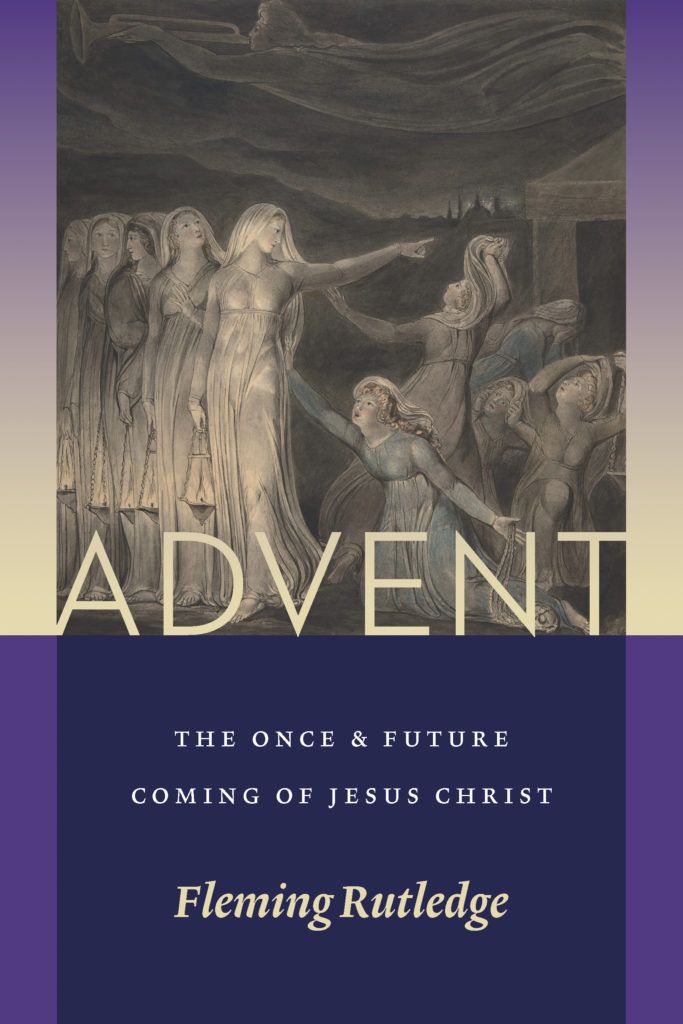Fleming Rutledge. Advent; the Once & Future Coming of Jesus Christ. Eerdmans, 2018. 406 pp.
So writes Fleming Rutledge, the Episcopal priest, author, and theologian who penned Christianity Today’s 2017 Book of the Year, The Crucifixion; Understanding the Death of Jesus Christ. In her latest work, Advent; The Once & Future Coming of Jesus Christ , she compiles a brilliant and engaging collection of Advent sermons ranging from 1975-present.
Rutledge begins with an introduction to Advent that every pastor will want to read as they begin to prepare to lead their own church through the beginning of the Christian year. The first part of the book contains a handful of Advent-related writings before moving on to “Pre-Advent” sermons on themes like the final judgment, the justice of God, and sermons for the Feast of Saint Michael and Christ the King. Ultimately it isn’t until page 251 that her formal Advent sermons begin.
Her primary contention is that the church has too often used Advent to prepare for Christmas and all the ornamental sentimentalism (what she refers to as “Christmas creep”) that comes with it rather than to seriously prepare for the second coming of Jesus and His final judgment.
She writes,
“The eschatological note of Advent, focusing on the second coming of Christ-the principal subject of this book-has been largely ignored even among the most enthusiastic Advent-lovers of late” (pg. 4).
I confess that as a pastor I have too often led our church through the season of Advent doing the very thing she cautions against; attempting to suspend belief that the incarnation has happened so that we can prepare for Christmas anew. It may be a surprise to readers that the original Advent themes were not hope, peace, joy, and love.
“…the Medieval church designed the four Sundays of Advent around the themes of the four last things: death, judgment, heaven, and hell- in that order, so that the subject of hell was preached on the Sunday just before Christmas Eve. That was no accident. The idea was- and is- to show how the light of the birth of Christ appeared against a backdrop of darkness, depravity, and despair.” (pg. 238)
Recently, in Florida, a disturbing and stomach-turning plot was uncovered at Bartow Middle School where two 11 and 12 year old students planned to hide in the bathroom, overpower smaller students, cut them up and eat them before turning a knife on themselves all in the service of Satan.
This, Fleming Rutledge would contend, is an Advent story. Or, in her own words, “Advent begins in the dark.”
That’s not quite as palatable to the contemporary church-going consumer. Which is why churches have forsaken these demanding themes that involve judgment and death in lieu of multiple “Christmas Eve” services that often begin two weeks before Christmas!
But as Rutledge insists, Advent isn’t a time to prepare for Christmas, rather its purpose is to “take an unflinching inventory of darkness” (pg. 173). Rutledge accomplishes this by telling stories that highlight the darkness displayed in human depravity via the most recent headlines, which she is effortlessly able to source year after year. Against this “backdrop of darkness” the light of Christ and the good news of judgment gleam even brighter as she proclaims the hope of God’s judgment on evil and the good news of the finality of Christ’s reign in the second coming.
I appreciate her repeated emphasis on the fact that there are not only two powers working in the world (humans and God), but three powers. Rutledge acknowledges her own tradition has largely made obsolete the embarrassing pre-enlightenment belief in a literal second coming and the “antiquated” notion of divine judgment. Rutledge is clearly not capitulating to mainline denomination norms as she proclaims the reality of an enemy force that is active not just in our world but in each of us.
My only criticism of this collection is that it can be quite repetitive. She acknowledges that this is a possibility in the beginning of the book, but it does not relieve the redundancy of some of the sermons. In one way, this repetition can serve to reinforce the major themes of Advent as she sees them, but it can also become slightly monotonous as it can feel like you are reading the same sermon over again with slightly different illustrations. I suppose the luxury of preaching at a variety of churches is that you can repeat material, but in a collection of sermons published to be read it can be wearing. However, as the book ends readers are rewarded for persevering as the final three sermons may be the highlight of the entire book.
A major concern for Rutledge is not just that we understand the proper themes of Advent, but that we as the church would begin to live as Advent people.
“The call is for the Church to reclaim for the sake of its own life and mission Advent’s focus on the reign of God and, in so doing, to hone once again the counter-cultural edge of the Gospel at the very beginning of the liturgical year.” (pg. 5)
If you can’t imagine the world you are heading toward, you can’t work toward contributing toward that world. Advent helps us to anticipate the kind of world that will be realized when Christ comes again to judge evil and renew all things.
She writes
“In our present lives we are both bearing witness to and waiting expectantly for the coming of the Lord. Bearing witness is an active stance; waiting is a passive stance. Both are part of the message of the herald of the age to come.” (pg. 12)
And so, locating ourselves as living between the Old age and the New age to come makes all the difference in the way the church conducts itself in the present.
But ultimately Advent tells us that
“The church is not called to be a ‘change agent’- God is the agent of change. The Lord of the kosmos has already wrought the Great Exchange in his cross and resurrection, and the life of the people of God is sustained by that mighty enterprise. The calling of the church is to place itself where God is already at work. The church lives, therefore, without fear, in faith that the cosmic change of regime has already been accomplished.” (pg. 12-13)
Recently, if you follow Fleming Rutledge on Twitter ( @flemingrut ), you would have read her response to a conversation on the labels “progressive” and “conservative.” She tweets,
Since I don't really believe in human "progress," I particularly dislike "progressive." Besides, "progress" toward what? Advent tells us that it is the Lord who "progresses" to us (Advent), not the other way around.
— Fleming Rutledge (@flemingrut) November 3, 2018
This is a good summary of Rutledge’s emphasis of God as the primary actor through all of human history and her realistic assessment of the weakness of humanity when unaided by the grace of God.
What this all means for the church on mission is that as we live in between the ages or “on the frontier of the turn of the ages” (pg. 13), we are marked by fearless living, radical forgiveness and the weapon of nonviolence. We recognize and regularly remember that there is a hostile enemy force that is engaged in seeking to thwart God’s mission as we resist evil and give witness to the coming reign of God in our service, prayer, and counter-cultural lives together. But ultimately our hope lies not in our own personal or communal efforts, initiatives, and agendas but rather the God of Advent who drew near to us in Jesus and who will come again to take away the darkness forever and be our eternal light.








